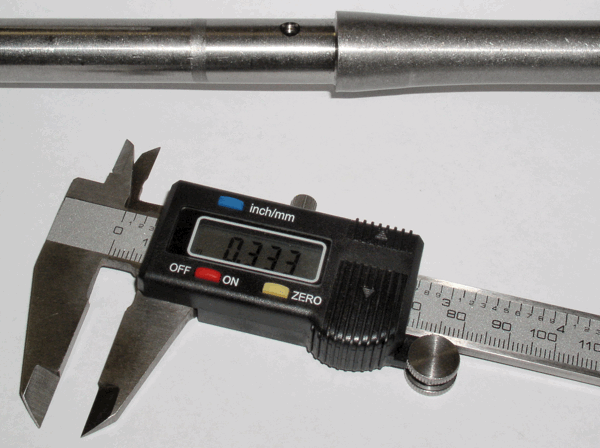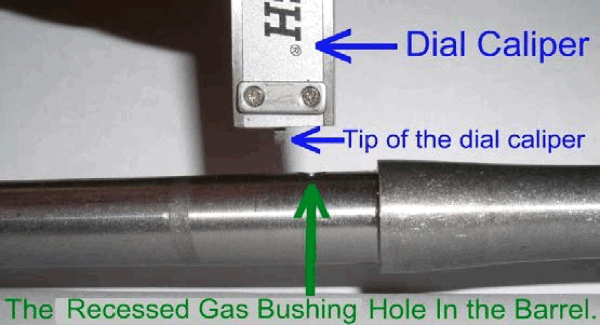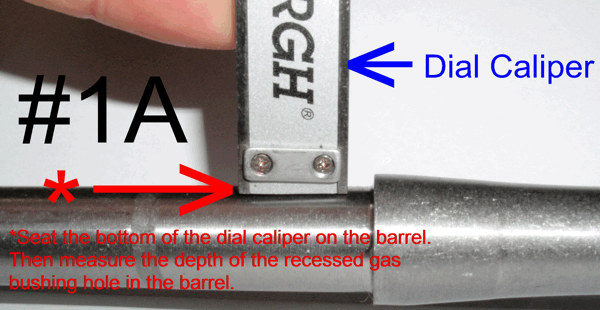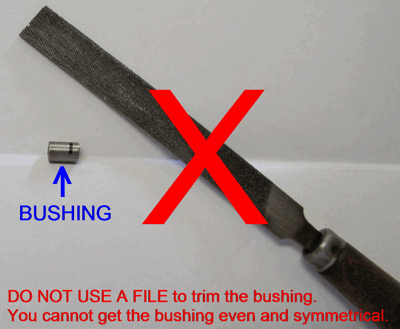*Important: TRIMING GAS BUSHING LENGTHS
For Adjustable Gas block and Harmonic barrel Stabilizer II Installations. NOTE: Gas Bushing Kits do not need trimming because they are designed to fit the Factory gas blocks or after market Non-Adjustable gas blocks which use factory gas pipes!
1. Determining the correct length and fit of the gas port bushing.- We have measured the depth of a wide selection of the Mini 14 and Mini 30 gas port bushing recess holes. This is the hole in the barrel that the gas port bushing seat’s down into. We have found that the gas port bushing hole varies in depth from rifle to rifle. If the gas port recess hole is to shallow this presents a problem when installing our Gas Block, Harmonic Barrel Stabilizer II or your gas block on your rifle.
- If the gas port recess hole is to shallow your gas bushing will be too long and this will keep the gas block from being seated flush and level against the barrel. You will experience the gas block ever so slightly teetering front to rear. *SEE Illustrations #8 & #9
- WARNING: If you go ahead and tighten the gas block with the bushing too long you will damage the gas pipe!
- The gas block or HBS II may look flush. However it is not! This situation will cause the gas pipe to be canted.
- You will then notice that the operating rod will not slip smoothly over the gas pipe and will bind up.
- If you have damaged the gas pipe there would be a charge of $29.99 for us to replace it.

- A Dial Caliper is recommended for measuring, but we do show below an alternative method for measuring that works quite well below the dial caliper illustration called the Q-Tip Method. *SEE Illustrations #1 & #3
- Measure the depth of the hole and keep the number from your reading. *SEE Illustrations #1A & #2
- Then Measure the length that the gas bushing protrudes from the gas block. *SEE Illustration #2
- Now subtract the amount the gas bushing protrudes from the gas block from the number you wrote down for the depth of the gas port bushing's recessed hole. This is the amount you will remove from the gas port bushing. You will also need to mark the difference on the bushing itself for a visual reference.



- With the Q-Tip method, cut off cotton at one end with a sharp razor. Leave no jagged end. This will be used for measuring the gas port bushing recess hole’s depth in the barrel. Now insert the cut end of the Q-Tip shaft into the gas port recess hole and mark the shaft with a fine point pencil like shown in *SEE Illustrations #2
- Now lay up beside the gas port bushing like shown in picture labeled (Illustration #3) the Q-Tip shaft and mark again with a second line. This will be your reference for the amount to be removed from the bushing.


4. Trimming the Length of the gas Port Bushing.
- Do not use a file. The bushing must be trimmed evenly and symmetrically.
- Now that you have marked the bushing this is how we recommend removing the Excess material. *SEE Illustrations #4, #5, #6 & #7.
- We assume you have an electric hand drill. *SEE Illustration #10.
- We want you to insert the bushing end that you are not going to trim into the drill chuck.
- With the reference line exposed tighten the chuck. *SEE Illustrations #10.
- Now select a drill bit that is slightly larger in diameter than the bushing. We recommend a 13/64” diameter bit. 118 or 135 degree cut are both fine. *SEE Illustrations #6
- Now we recommend using a glove to hold on to the drill bit firmly in one hand and the electric drill in the opposite hand. *SEE Illustrations #10.
- Start the drill spinning and while it is spinning with the other hand press the drill bit against the gas port bushing. You will want to press only hard enough so that you see metal coming off of the gas port bushing.
- When you have reached your mark on the gas port bushing you are finished.
- Now remove the bushing and inspect it to make sure there are no bur’s left on it and if there are remove which some emery paper.
- Take the bushing and with the side you just removed material from there will be a nice funnel shape, put this end toward the barrel, this will help to funnel the gas more effectively into the gas block.










